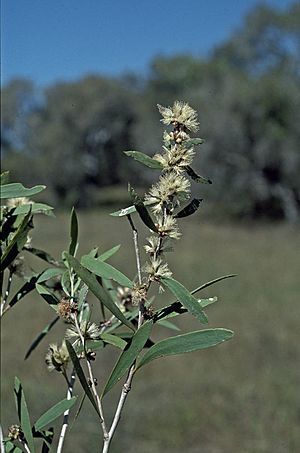Saltwater paperbark facts for kids
Quick facts for kids Saltwater paperbark |
|
|---|---|
 |
|
| Scientific classification | |
| Genus: |
Melaleuca
|
| Species: |
alsophila
|
| Synonyms | |
|
Melaleuca acacioides subsp. alsophila (A.Cunn. ex Benth.) Barlow |
|
The Melaleuca alsophila, often called the saltwater paperbark, is a plant from the Myrtaceae family, which includes myrtle trees. This plant is special because it grows only in the northern parts of Western Australia. It can be a thick bush or a small tree with bark that feels like paper or has lots of fibers. You often find it in areas that get flooded during the wet season.
Contents
What Does It Look Like?
The saltwater paperbark can grow into a dense bush or a tree up to 15 m (50 ft) tall. It often has many stems. The leaves can be different sizes, even on the same plant! They are usually 10–50 mm (0.4–2 in) long, flat, and have 5 to 7 veins. They grow in a spiral pattern around the stem. The leaves are typically shaped like an oval or a tear-drop, getting narrower near the branch.
Its flowers are creamy white and grow in small, thick clusters. The tiny parts of the flower called stamens are grouped into five bundles. Each bundle has about 9 to 16 stamens. This tree flowers during the dry season, from March to October. After the flowers, it grows hard, woody seed pods. These pods are about 2 mm × 2 mm (0.08 in × 0.08 in) and look like a cup or a barrel. They can grow alone or in small groups.
Where Did Its Name Come From?
The Melaleuca alsophila was first described by a botanist named Allan Cunningham. He found a sample of the plant on the northwest coast of Australia while on a trip with HMS Beagle. Later, in 1866, George Bentham officially named it in a book called Flora Australiensis. The second part of its scientific name, alsophila, comes from two Greek words: alsos, which means "grove," and philos, which means "loving." This name describes how the plant loves to grow in groves or groups.
Where Does It Grow?
You can find the saltwater paperbark in sandy soils, which are often salty. It grows along rivers, in swamps, on floodplains, and in other salty areas near the coast. It is found in several different natural regions of Western Australia, including the Central Kimberley, Dampierland, Northern Kimberley, Victoria Bonaparte, Great Sandy Desert, and Pilbara.
How People Use This Tree
Aboriginal people in the Kimberley region know that pigeons love to rest in these trees. They used the tree trunks to build shelters. Native, stingless bees often make their homes inside the trunks and branches. The bark can also be used to keep mosquitoes away. Plus, a special tea made from its leaves can help with cold symptoms.
Is It Safe?
The Government of Western Australia's Department of Parks and Wildlife says that Melaleuca alsophila is "not threatened." This means it is not currently in danger of disappearing.
Other Cool Plants
- Melaleuca cuticularis, which is also known as the saltwater paperbark.

